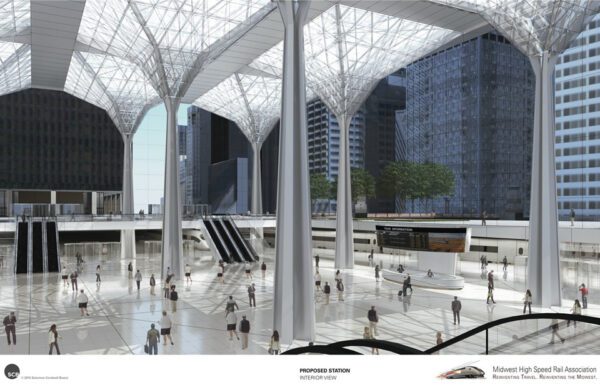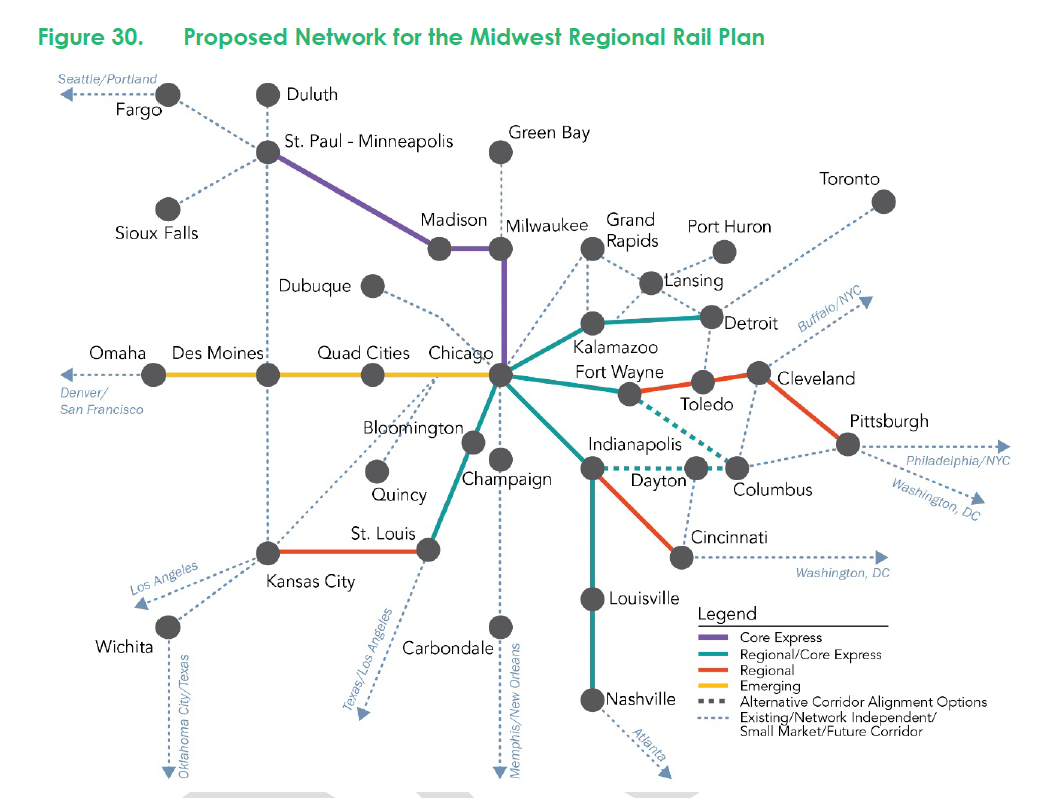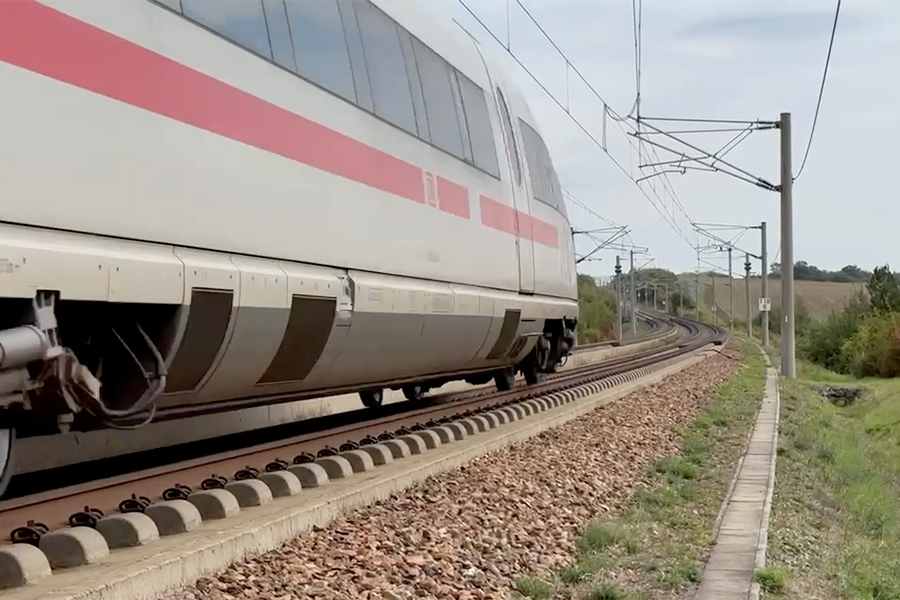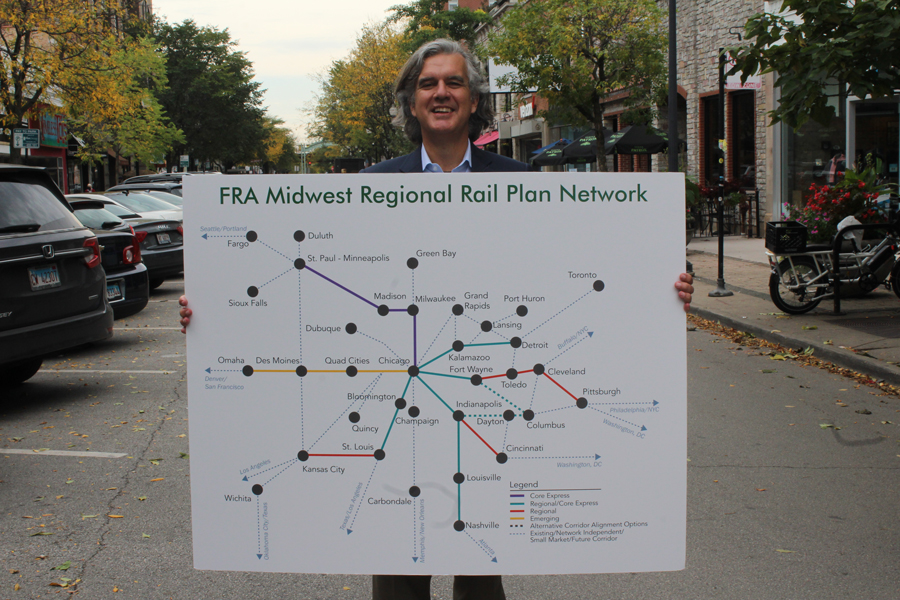The City of Madison tackles the station location challenge The City of Madison Department of Transportation recently released a study of potential train station sites. It identified a first choice and a “Plan B” alternative from a list of nine contenders. Two other...
The Federal Railroad Administration’s Midwest Regional Rail Plan, released today, is a milestone achievement that should be celebrated and heeded on three fronts.
First, it lays out a compelling vision for an network of high-speed trains that would transform travel across the Midwest. Second, it makes a strong case for fast, frequent trains that are coordinated and well-integrated into a network. While speed gets most of the spotlight when people talk about trains, frequency and coordination are key to leveraging the full power of a rail network. Third, it points out the urgency of regional cooperation and big-picture planning.
The plan envisions a network that consists of several “pillar corridors” radiating out from Chicago, with endpoints in Minneapolis-St. Paul, St. Louis, Indianapolis, and Detroit. These corridors are the system’s backbone. Their real power, though, isn’t that they would move people at high speeds from point to point within each corridor. Their power lies in the way they would make connections much faster and easier between hundreds of cities throughout the Midwest.
That’s because the “pillar corridors” would integrate with transit systems and regional lines that connect mid-sized and major cities—like Indianapolis and Cincinnati, and Kansas City and St. Louis. There would be between 16 and 24 daily roundtrips trains per day on the “pillar” lines—a vast increase over current service levels for U.S. passenger trains.
Incorporating these different lines into an integrated network—as the Midwest Regional Rail Plan envisions—would give travelers lots of new options.
The report notes, for example, that there are 189 connections between city pairs if the corridors in the plan are considered as standalone entities, independent of the others. But in a network model—i.e., a model in which travelers can transfer easily between two corridors—the city-pair connections increase to nearly 1,100.
As a result, projected ridership increases to 17 million annual trips by 2055—versus 12 million in the standalone model—and annual revenues increase 59 percent over the standalone model.
The power of the phased network approach
A new 186+ mph high-speed line linking Chicago and Minneapolis-St. Paul—with intermediate stops in Milwaukee and Madison—is the foundation of the plan’s strategy. As the authors observe, “Chicago remains the core driver of intercity ridership throughout the network, accounting for nearly 30 percent of all trips in 2055. Minneapolis-St. Paul is the second largest market, with over 11 percent of trips originating or ending there.”
It’s important to underscore: This isn’t just about Chicago, Minneapolis-St. Paul, and the cities in between. The effects would be far-reaching and profound.
For example, the line would change the calculus by providing frequent service from Milwaukee to St. Louis and from Indianapolis to Minneapolis. These routes don’t have enough ridership to justify investments as standalone high-speed lines. As part of an integrated network, they make perfect sense.
That’s why integrated rail networks are so powerful and promising: Strategic investments in individual corridors create ripple-out effects that improve service—and deliver big benefits—across entire regions.
A line between Chicago and Indianapolis is especially intriguing, given that it would incentivize extending the service on to Louisville and Nashville. The population of greater Nashville, which is currently a little under 2 million people, is projected to rise dramatically over the next several decades. According to current projections, the city will be about the size of St. Louis in 2055—i.e., a little over 3 million people. That means it will be larger than any city in the Midwest except for Chicago, Detroit, and Minneapolis-St. Paul.
Fast, frequent service between Nashville, Indianapolis, and Chicago would not only affect travel between those cities. It would also incentivize investments in connecting corridors—for example, lines from Indianapolis to Columbus and Cincinnati—and “provide a gateway connection to Atlanta.”
As the Alliance noted recently, this is how a national network could develop in the U.S. over the coming decades: The Chicago to Minneapolis-St. Paul line could incentivize an upgraded line from Chicago to Indianapolis, which could incentivize lines to Nashville and Atlanta. At the same time, high-speed lines are currently being planned from Atlanta to Charlotte and Atlanta to Dallas.
If and when these elements are in place, much of the Midwest, Southeast, and East Coast will be connected by a flourishing network of first-class passenger trains. (For the purposes of the report, the Midwest is defined as 12 states: Illinois, Indiana, Iowa, Kansas, Michigan, Minnesota, Missouri, Nebraska, North Dakota, Ohio, South Dakota, and Wisconsin. Together, their population of nearly 68 million people in 2016 accounted for roughly one-fifth of the nation’s total population.)
Plan, plan, plan
 A bold redevelopment of Chicago’s Union Station will pay dividends to the region.
A bold redevelopment of Chicago’s Union Station will pay dividends to the region.
One of the Midwest’s strengths is its long history of cooperation on railroad development. Building on this history will be key to the region’s success. As the report notes, “if funding for regional rail development becomes available, the Midwest states will have to act immediately.”
Chicago’s Union Station is an excellent example of how local, high-impact projects can have implications well beyond Illinois—and thus demand regional, big-picture thinking.
Union Station was the fourth busiest rail station in the U.S. in 2019, serving more than 3.3 million passengers. (The next busiest station in the Midwest, Milwaukee’s Intermodal Station, served only 640,000 people.) But the kind of network the Midwest Regional Rail Plan envisions will require much more from the facility. It is destined to handle many hundreds of thousands—perhaps millions—more travelers each year.
The Alliance has long argued for bringing Union Station into the twenty-first century with renovations that vastly increase its capacity to handle more travelers and more trains. And we agree wholeheartedly with the report’s premise that high-impact projects like the Union Station renovation should be integrated into a big-picture plan.
As of right now, working out the details will be up to the states. For the sake of our collective future, they should begin that work immediately. Initiatives like the recently formed Illinois High Speed Rail Commission are a great start. Ultimately, the states should work together to win the federally led railway program needed to make this and other projects successful.
The tremendous value of the Midwest Regional Rail Plan is that it offers a broad vision of what a regional network of fast, frequent trains could look like. The report will hardly be the last word on the subject. But in making the case for why the states must work together to get this done—and why fast, frequent trains and a phased network approach are crucial to success—it marks a huge step forward for the Midwest and the nation.

Help Strengthen Your Community
Tell the United States Congress: It’s time to reconnect the country with high-speed and regional rail!
The Latest from HSRA
Our Latest Blog Posts
Check out the latest news, updates, and high speed rail insights from our blog!




